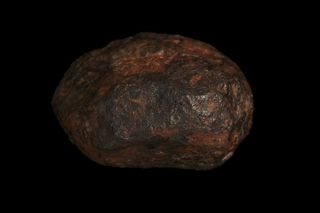Extraterrestrial Mineral Never Before Seen on Earth Found Inside a Famous Meteorite

The Wedderburn meteorite was first discovered in 1951.
(Image: © Rodney Start/Museums Victoria/CC BY 4.0)
According to a new study first reported by the Australian news site, The Age, the mineral doesn't naturally occur anywhere on our planet; as such, it’s been seen only as a man-made version.
The Wedderburn meteorite was first discovered in 1951 near Wedderburn in Victoria, Australia, and is now part of the Museums Victoria collection. When it was first found, the rock was "lemon-sized" and weighed 210 grams (7.4 ounces), according to the Museums Victoria Collections. Since the space rock’s discovery, researchers from around the world have been studying slices of it to understand what it's made of and where it came from.
Last year, researchers at the California Institute of Technology conducted the latest of such studies. Using an electron-beam microscope and electron probe, they analyzed a slice of the space rock and happened upon a rare, previously unnamed mineral that doesn't naturally occur on our planet.
Related: Shine On: Photos of Dazzling Mineral Specimens
O mineral é constituído por um padrão especial de átomos de ferro e carbono. Os pesquisadores o nomearam "edscottite", em homenagem a Edward R.D. Scott, um cosmoquímico da Universidade do Havaí em Manoa. Scott foi o primeiro a descobrir esse mineral no meteorito e determinar sua composição química no início da década de 1970, mas não conseguiu determinar sua estrutura cristalina, disse o principal autor Chi Ma, cientista sênior de equipe e mineralogista da Caltech.
A mineral is defined by a chemical composition and crystal structure. For example, both diamond and graphite are both made up of carbon, but they have different crystal structures, Ma said. In this new study, Ma and his team figured out the mineral's crystal structure and thus had it approved as a new mineral.
The Wedderburn meteorite likely came from an asteroid that "somehow got knocked off its course and headed to Earth," Ma told Live Science. The meteorite itself is likely the shattered remains of a small planet that collided with other celestial objects in the early solar system, he added. The mineral edscottite could have formed when nickel-rich iron meteorites such as Wedderburn slowly cooled, he said.
"Every mineral has a voice and its own story to tell," Ma said. "Each new E.T. mineral represents a distinctive formation environment and can provide insights into processes active in the solar nebula, on asteroids, the moon and Mars." Ma and his team hope to analyze other meteorites to check if they also contain edscottite.
The findings were published Aug. 28 in the journal American Mineralogist.
Editor's Note: This article was updated to clarify that Scott was the first to discover this mineral in the meteorite back in the early 1970s, but he wasn't able to determine its crystal structure. In this new study, the researchers found the minerals crystal structure and had it approved as a new mineral.
- Photo Gallery: Images of Martian Meteorites
- Fallen Stars: A Gallery of Famous Meteorites
- In Photos: The Impact Craters of North America
CLOSE
Nenhum comentário:
Postar um comentário
Observação: somente um membro deste blog pode postar um comentário.